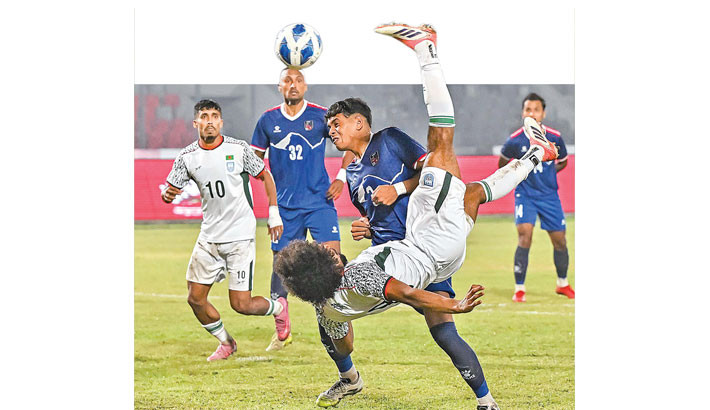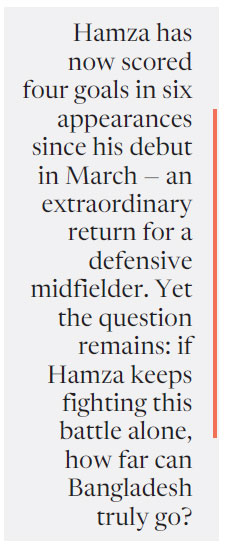
COLLECTED PHOTO
Hamza Choudhury once again delivered a stellar individual performance for Bangladesh, but Thursday’s 2–2 draw against Nepal exposed a troubling reality: how long can one player carry an entire team?
The Leicester City midfielder, who usually operates as a defensive anchor, was at the heart of nearly every significant moment for Bangladesh. Dropping deep between the centre-backs to initiate attacks, pressing high to unsettle Nepal’s defence, threading incisive through balls, and timing late runs into the box with lethal precision — Hamza’s versatility and influence were un-mistakable.
His second-half heroics nearly won the game singlehandedly.
After Bangladesh fell behind due to poor defending, Hamza surged forward, scoring twice within minutes — including a breathtaking bicycle kick — to turn the tide. For 80 minutes, he was eve-rywhere: orchestrating from midfield, shoring up the defence, and finishing like a striker.

But herein lies the problem. Too often, Hamza was isolated amid teammates who failed to match his tempo and vision. When he found space inside Nepal’s box and signalled for the ball, it was ignored, with rushed and inaccurate shots replacing what could have been coordinated play. It was only after Shamit Shome’s introduction that Bangladesh briefly showed cohesion, his pace and awareness unlocking the spaces Hamza craved.
When Hamza left the field injured, Bangladesh lost control. Nepal’s late equaliser — a cruel echo of October’s collapse against Hong Kong — underscored deeper issues.
Coach Javier Cabrera admitted the team trains repeatedly for such pressure situations but struggles to execute when it matters.
Despite having no domestic football for nearly 1,000 days, no proper stadiums, no grassroots structure, and players who often struggle just to secure regular meals, Nepal’s footballers showed remarkable grit, discipline, and hunger on the pitch. Eight members of their squad cur-rently play in the Bangladesh Football League, yet several Nepal players had only recently been part of protests demanding the return of domestic football at home.
And still, even amid such hardship, Nepal’s players performed with intensity — a stark contrast to a Bangladesh team enjoying every possible advantage: a functioning league, extended train-ing camps, better facilities, and structured preparation.
Yet many Bangladeshi players continue to struggle for consistency, leaving the team dispropor-tionately reliant on two men who fly thousands of miles to represent the country.
While Hamza’s brilliance shone, the draw exposed Bangladesh’s over-reliance on a lone star, masking weaknesses in squad depth, tactical balance, and collective understanding.
The team need more players who can share defensive duties, support transitions, and contribute consistently in attack. Until then, Bangladesh will keep oscillating between flashes of brilliance and frustrating setbacks.
This match was a key warm-up ahead of Bangladesh’s AFC Asian Cup qualifier against India on 18 November. Hamza has now scored four goals in six appearances since his debut in March — an extraordinary return for a defensive midfielder.
Yet the question remains: if Hamza keeps fighting this battle alone, how far can Bangladesh truly go?

